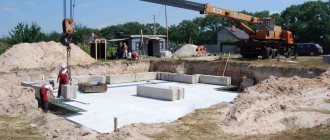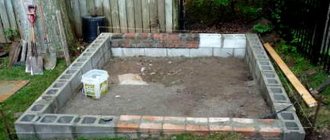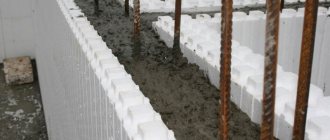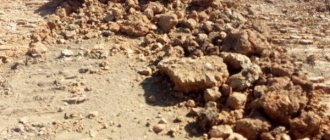Thanks to this innovation, the technical parameters of the building are improved, noise in the premises and heating costs are reduced.
Read on to learn about the design of the structure, technical characteristics of materials and the nuances of self-installation of formwork.
Options and characteristics
The density of the material is the determining factor by which products are divided into brands. The thermal conductivity and strength of the product directly depend on this indicator. Let's consider the technical characteristics of various types of foam:
- PSB-S 15. These are slabs with low density (15 kg/m³). They are extremely lightweight and suitable for insulating structures in which people stay temporarily.
- PSB-S 25. Material density 25 kg/m³. It is used to insulate facades, floors, and roofs.
- PSB-S 35. Excellent technical characteristics make the product in demand in the manufacture of sandwich panels and reinforced concrete structures.
- PSB-S 50. Extremely dense material. The slabs are used for arranging floors inside refrigerated warehouses and in road construction.
- Extruded polystyrene foam. The thermal conductivity of the product is ideal. The material also has different densities (25–47 kg/m³).
In production, foam formwork is made in different ways:
- Hollow blocks with removable or non-removable stiffeners. The products are similar to LEGO construction blocks.
- Facing option.
- Reinforced panels reinforced with mesh.
In addition to these basic options, they also produce polystyrene foam blocks that have a curved configuration. They allow you to pour non-standard types of foundations.
Arrangement of the foundation of a building without the use of formwork
In some cases, it makes sense to make a foundation without using any formwork. For example, during the construction of a small building, some excess consumption of concrete is compensated by the simplicity and speed of casting the concrete base. Of course, such a foundation is not suitable for a house with a basement. Moreover, without the use of formwork, the foundation can be built on soil that does not crumble, that is, with a certain clay content.
Pouring a strip foundation without the use of formwork
To arrange a strip foundation, a trench is dug under it in accordance with the contours of the building and a depth of up to 1 m. A sand cushion is laid at its bottom in a layer of 10-15 cm. The sand is moistened and thoroughly compacted. To improve the characteristics of concrete, it is recommended to cover the side walls of the trench with roofing felt or thick polyethylene. Next, a frame of reinforcement is built and concrete is poured.
This is interesting: Floor-to-ceiling windows on the balcony: let’s write down the main thing
Advantages and disadvantages
Expanded polystyrene formwork consists of several blocks that are connected together. The advantages of this design are as follows:
- the material simultaneously performs two functions: sound-proofing and heat-insulating;
- the elements are easy to assemble, so installation of the formwork is quick;
- due to the characteristics of the material, it is convenient to lay utility lines in the foundation;
- the low weight of the products allows you to move them without renting special equipment;
- foundation construction is allowed even in slight frost;
- concrete protected with polystyrene foam is not susceptible to fungal attack;
- there are no “cold bridges”;
- The material is environmentally friendly, it has a smooth surface.
However, polystyrene foam formwork cannot be considered a panacea that saves the developer from all troubles. Although the material has many positive parameters, it is not without some disadvantages:
- poor air permeability makes the room excessively humid;
- polystyrene foam is a flammable material;
- installation of permanent formwork when hiring specialists is too expensive.
Having studied the pros and cons of polystyrene foam products, everyone chooses the possibility of using it for the manufacture of formwork. All you need is to purchase the material and also have a little skill in installing it.
Video about the advantages and disadvantages of polystyrene foam (expanded polystyrene, EPS, EPS):
Advantages of monolithic construction technologies
Let us list the main advantages of monolithic construction:
- Lightened weight of buildings, compared to brick ones by 12-20%
- As a result of reducing the load on the foundation, and provided that the bearing capacity of the foundation soils and their low heaving are ensured, economical types of non-buried foundations are possible. the foundation can provide significant savings - up to 25%
- The monolithic house is seamless, without cold bridges, with good insulation. To be fair, it should be noted that the problem of the most powerful cold bridge - the base of the foundation - is not solved by permanent formwork. This issue, if necessary, can be resolved by additional insulation in the base and the installation of a warm blind area.
- All installation work is carried out on our own, without the use of heavy equipment. Technologies are quite accessible to private builders.
- The savings in usable space are significant, since the thickness of the external walls is reduced. A building with an area of 200 m2, compared with a brick house, is 20-25 m2 more spacious
- The durability, strength and stability of buildings using permanent formwork technology is comparable to stone and brick buildings with construction costs 1.2-1.5 times less
Transportation and storage of blocks and panels of permanent formwork can be carried out either disassembled or whole. All metal parts and surfaces must be protected from corrosion before packaging.
Prices for materials and installation
The products are sold by many construction stores. There are many companies that provide professional services related to the installation of such formwork and pouring concrete mixture into it.
Advice. If you want to save money, it is better to purchase material from those who perform the full production cycle - from the manufacture of parts to their installation.
Before purchasing, you must definitely calculate the exact number of blocks required, taking into account that some of them may be damaged during installation. The estimated cost of the parts is as follows:
jumper - 10 rubles;- straight and corner element - 780 rubles;
- cap - 20 rubles;
- rotating block - 800 rub.;
- end part - 780 rubles;
- angle of 135° - 500 rubles;
- right angle - 500 rub.;
- standard unit - 495 rub.
The average cost of installation work is 225 rubles/sq.m. m.
Reviews
This year my husband and I got married and decided to buy a home. There wasn't enough money to buy a new one. We settled on building a house, but the option is also not a cheap one. To reduce costs, we used polystyrene foam formwork. We managed to spend less money and were able to build a house faster.
Olya. Krasnodar.
Our company is engaged in the construction of houses. Pouring a concrete base using foam blocks significantly reduces the time for building construction.
Alexander. Chrysostom
Step-by-step construction with your own hands
The step-by-step assembly process looks like this:
The first step is to dig a trench or pit under the perimeter of the foundation (read about how the volume of excavation work is calculated when developing a pit, and from this article you will learn how much it costs to dig a trench under the foundation and how to do it correctly).- Then the bottom is leveled and the pillow is covered. It is better to make it from gravel, carefully leveling it with sand on top.
- Then the required base width is determined. This value is variable and depends on various factors. Traditionally, it is customary to make a foundation 30–60 cm wide.
- A foam sheet with a thickness of 5 cm is laid on top of the sand backfill. This lining guarantees excellent thermal insulation of the concrete mixture.
- After this, the corners of the structure are formed using special screws. EPS sheets are suitable for the internal as well as external walls of foam formwork.
- The layers are joined by performing a slight shift. This prevents concrete from leaking through the cracks.
- The installed walls are connected to each other, for which you will need universal ties. They allow you to accurately set the required width of the foundation, being at the same time guides and mortgages for the formation of the reinforcement frame. Everything in purchased products is clearly thought out, so assembling such a construction set is simply a pleasure.
- Having fastened the lower part with ties, install ventilation vents in several places, and then attach a horizontal reinforcing layer. Typically, sections of plastic pipes with a diameter of 110 mm are used for vents. They are easy to cut using a regular grinder.
- Metal rods are securely fastened with clamps located both on the inner and outer edges of the blocks. Fiberglass can also be used as reinforcement instead of steel. It is even more preferable, although in practice metal is traditionally used.
- When the creation of the lower reinforcing belt is completed, the next universal ties are attached at the top of the formwork, which hold the sheets together. The upper reinforcing belt is mounted on them.
- The final stage of the formwork installation is the fastening of the vertical elements of the metal frame. All intersections of the rods must be tied using soft wire.
After this, the permanent formwork, containing a reinforcement cage inside, is ready for use.
Attention! After pouring the concrete mixture into it, you only need to walk through the liquid mass with a vibrator to remove air pockets. When there is no such device, you will have to use the old-fashioned method - “pierce” the liquid solution with a stick.
From the video you will learn what permanent polystyrene foam foundation formwork is and how it is installed:
Installation instructions for polystyrene foam formwork
The construction of monolithic structures with permanent forms does not require high qualifications. Even novice builders can handle this work, and for a small project only two people will be enough. Before you begin, you need to prepare the required number of polystyrene foam blocks and agree on timely delivery of concrete.
The installation process is divided into several stages.
Formwork assembly
To install the first row of blocks, you will need to prepare a waterproofed base. Vertical reinforcement bars connecting the wall being built and the foundation are mounted in advance, and the blocks are placed on top of them.
When assembling the first row, you should especially carefully check that the dimensions correspond to the project in order to prevent even the slightest deviations.
Subsequent rows are erected with an offset of half a block, so that the seams are bandaged and the structure becomes more rigid.
Reinforcement tying
In addition to vertical reinforcement, designed to secure the base and wall, to ensure the strength of the monolith, it is necessary to create horizontal connections. In each row, horizontal rods are laid overlapping. They are connected to each other with steel wire, which is also used to connect them to vertical rods. Rigid reinforcing mesh prevents heavy concrete from pushing light blocks out.
Pouring concrete
Before starting work on pouring the mortar into the formwork, all communications should be laid. After concrete gains strength, it will be impossible to install wiring and plumbing pipes inside the walls. To pour monolithic walls into polystyrene foam forms, concrete with fine fillers is used.
It is prohibited to pour more than three rows of formwork. After pouring, the concrete is compacted with a vibrator and leveled. Gradually increasing the formwork and pouring the mortar, the design parameters are achieved.











